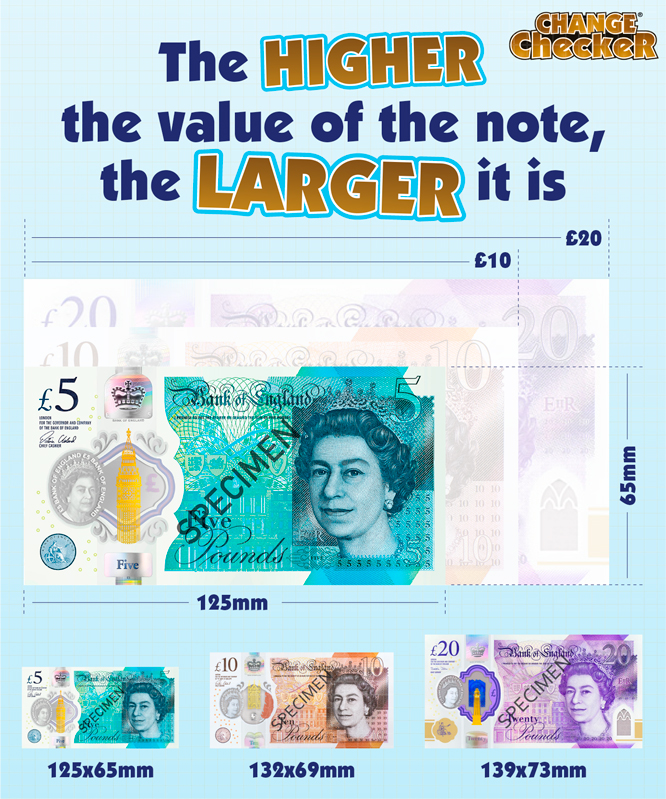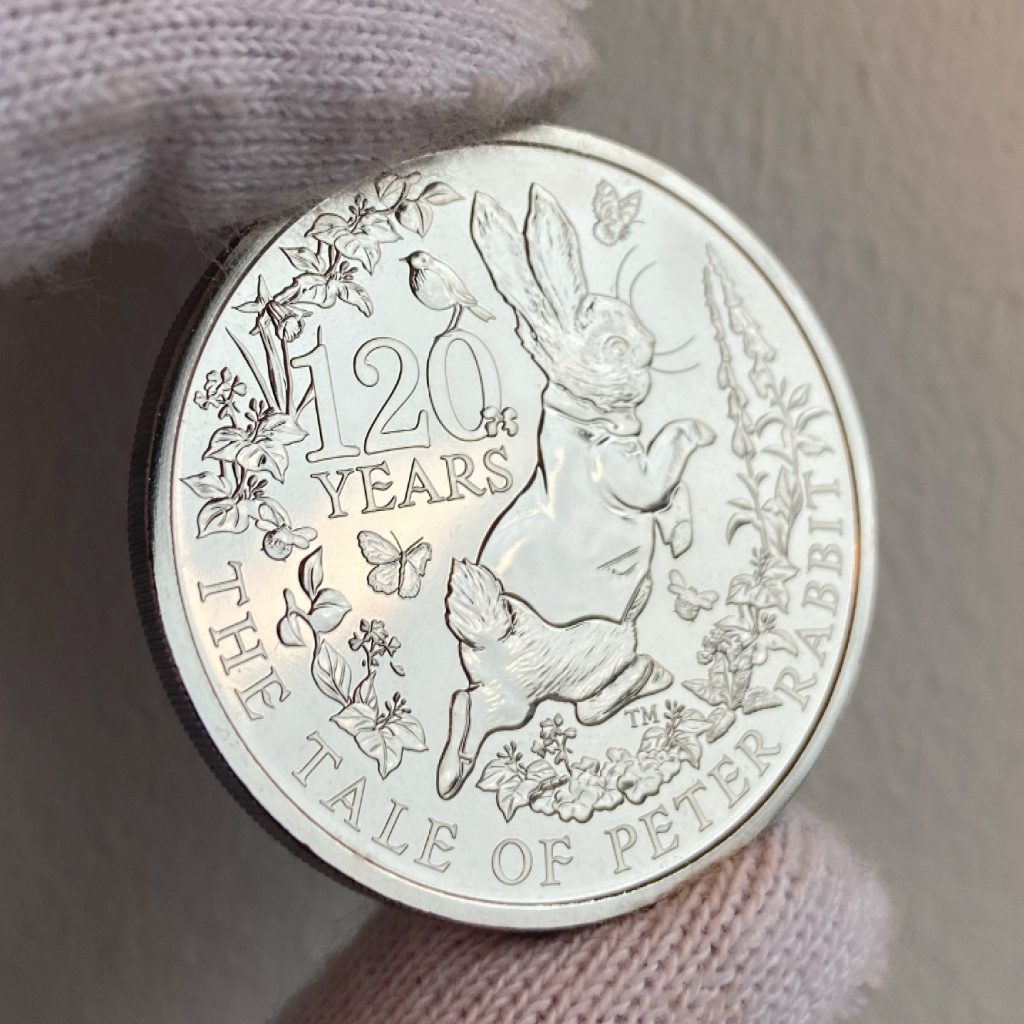UK coins
How to spot a counterfeit banknote!
In 1725, printed banknotes were first introduced in the UK, with the purpose of fixed denominations. The £20 banknote came first and following a shortage of metallic currency during the Seven Years’ War in 1759, £10 and £15 notes were issued.
The £5 note was the last to be introduced in 1793. But since their introduction, banknotes have been subject to fraudulent behaviour, so much so, additional banknotes have been executed partly to make forgery of such more difficult.
Fraudulent notes are also called ‘counterfeit banknotes’ and although less and less are going into circulation — with less than 1 in 40,000 banknotes being counterfeit in 2021 — it’s still an important topic to discuss!
Although polymer banknotes are a lot harder to replicate than the traditional paper ones, you should still check your notes when you receive them. But the questions is, how do you spot a counterfeit banknote?
Sizing
For every polymer banknote, a good starting point is to look at its size.
The higher the value, the larger it is. Here we can see the approximate sizes of the £5, £10 and £20 polymer banknotes:

Security Features
Crucially, you should always check your polymer banknotes for the following key security features:

Changing hologram:
- All polymer notes when tilted from side to side and up and down, should feature word changes within their holograms.
- For the £5 banknote, the words should change between ‘Five’ and ‘Pounds’, the £10 banknote between ‘Ten’ and ‘Pounds’ and so on.
See-through windows:
- Each banknote of denomination has a metallic image over the see-through window on it.
- Both the £5 and £10 polymer notes have gold foil on the front of the note within this part and silver on the back.
- The £20 note has a blue and gold foil on the front of the note for the metallic image and silver on the back.
- Lastly, the £50 note has gold and green foil on the front and silver on the back.
Feel of polymer and raised print:
- Polymer is a thin and flexible material so check that the material of your banknote feels this way.
- On each denomination banknote as well, the words ‘Bank of England’ should feel raised.
Foil patches:
- Each banknote denomination will have a different foil patch on it.
- For the £5 note, this is a green foil patch — it is circular and spells ‘BLENHEIM’ to commemorate where Churchill was born.
- The £10 note has a copper foil patch, and this is shaped as a book.
- Check it contains the letters ‘JA’, in tribute to Jane Austen.
- A purple foil patch shaped in a circle with a ‘T’ at its centre, to represent JMW Turner, is imprinted on the £20 note and lastly, a metallic red foil patch can be found on the £50 note and contains the letters ‘AT’ for Alan Turing.
- The patches can all be located behind the silver crown on the front of the notes.
The queen’s portrait in the see-through window:
- The Queen’s portrait which is printed within the see-through window can be found on all the banknotes with the respective denomination and the words ‘Bank of England’ printed twice.
- For example, on the £5 note the inscription ‘£5 Bank of England’ will be printed twice around the windows edge.
This is a just a small selection of the security features that you can find on your polymer banknote. Can you name some of the other features? Let us know in the comments below!
Counterfeit banknotes have no monetary value and cannot be reimbursed. The best thing to do if you encounter a counterfeit banknote is take it to your nearest police station.
They will ask you to fill out a form and once taken from you, will send the suspect note(s) to the National Crime Agency and if found to be counterfeit, to the Bank of England for further examination.
If you’re interested in coin collecting, our Change Checker web app is completely free to use and allows users to:
– Find and identify the coins in their pocket
– Collect and track the coins they have
– Swap their spare coins with other Change Checkers
Sign up today at: www.changechecker.org/app
120 Years of Mischief – the 2022 Peter Rabbit £5 just issued!
I can remember the very first time I was introduced to Peter Rabbit.
My grandmother, an avid Beatrix Potter fan, read me the tale of this mischievous little bunny rabbit one evening. From that point on, every time I went to stay with her, it would be the bedtime story I requested.
That’s the wonderful thing about The Tale of Peter Rabbit; it’s adored across generations.
From the original books, written in 1902, to the brand new £5 coin issued today, the nation continues to preserve Peter Rabbit’s legacy.
2022 UK Peter Rabbit™ £5
In celebration of 120 years of mischief, The Royal Mint has issued a brand new £5 coin, featuring a design of Peter Rabbit, straight from the storybooks!
Designed by Ffion Gwillim, this brand new coin shows the famous bunny rabbit in the stance that is famously known for being the emblem of Beatrix Potter’s works.
The coin also features the inscription ‘120 YEARS’ and ‘THE TALE OF PETER RABBIT’, in tribute to both Beatrix Potter’s talents and her most cherished character.
The popularity of previous Beatrix Potter releases first caused a collecting frenzy in 2016. Having remained some of the most popular coins amongst collectors ever since, this brand new £5 coin is expected to be incredibly sought-after – especially during this special anniversary year!
To secure yours for your collection in Brilliant Uncirculated quality for JUST £10.99 (+p&p), click here.
2021 UK Peter Rabbit™ £5
In 2021, Peter Rabbit made his first ever appearance on a UK £5 coin – the flagship issue, regarded as the UK’s most important commemorative coin amongst collectors.
Featuring a reverse design by Ffion Gwillim, the same artist behind this year’s stunning anniversary issue, this £5 coin depicts a charming scene of the whole rabbit family.
The perfect keepsake to treasure forever, this £5 coin proved incredibly popular with collectors!
With 2022 being a very special anniversary year for Peter Rabbit, i’m sure demand will be even higher for this brand new issue.
Do you have fond memories of Peter Rabbit?
Perhaps you were read the stories as a child, or maybe you’re now reading them to your children or grandchildren? Let us know in the comments below!
Secure the 2022 UK Peter Rabbit™ £5 coin for your collection!
This Peter Rabbit™ £5 coin has been specially struck and encapsulated as a Change Checker CERTIFIED Brilliant Uncirculated issue.
Brilliant Uncirculated coins are specially struck and handled by The Royal Mint to ensure they are a higher standard than the coins in your change.
It has then been protectively encapsulated in Official Change Checker packaging with the all-important security hologram to guarantee its quality forever.
Own the 2022 UK Peter Rabbit™ £5 today in superior Collector Quality, for JUST £10.99 (+p&p) by clicking here >>
£19bn in old UK banknotes and coins not cashed in!
£18.9bn worth of paper banknotes and round pounds remain in circulation, with over 113 million of these being £5 notes! Despite it being nearly five years since the paper £5 note lost its legal tender status*, it seems people are holding on them.
In fact, you might just have one in your pocket/wallet/down the back of the sofa right now!

Whilst the paper £10 and £5 notes have been withdrawn from circulation, the £20 and £50 paper banknotes will hold their legal tender status until 30 September 2022.
According to the Bank of England, 775 million paper banknotes remain in circulation:
- Paper £5 notes in circulation: 113 million
- Paper £10 notes in circulation: 73 million
- Paper £20 notes in circulation: 360 million
- Paper £50 notes in circulation: 209 million
That’s a lot of banknotes!
*Whilst the paper £5 and £20 notes are no longer legal tender, they will always be exchanged by the Bank of England for their face value.
There are also supposedly £105m of old round pound coins in circulation, according to the Royal Mint.
After more than 30 years in the nation’s pockets, the familiar round £1 coin was replaced with an all new, 12-sided £1 coin in 2017, in a bid to crack down on counterfeiting.
It lost its legal tender status at midnight on 15 October 2017 and the Royal Mint asked the public to return their round pounds as they phased in the new 12-sided coin.
However, out of 1.6 billion round pounds to be returned, about 1.45 million were counterfeits!
The UK’s 12-sided £1 coin is described by the Royal Mint as the ‘most secure in the world’, with a string of anti-counterfeiting details. Find out more about the security details of this coin here!
Round pounds can still be deposited at high street banks – but can no longer be spent in shops.

Have you held on to your round pounds or paper notes? Let us know in the comments below!
Never miss a UK coin issue!
Join the Change Checker UK CERTIFIED BU Subscription Service and receive new UK coins sent to your door without the hassle of placing orders on the day of release!
Don’t miss your chance to get ahead of the crowd and be one of the very first collectors to receive the latest UK new issue coins as soon as possible after their release.





